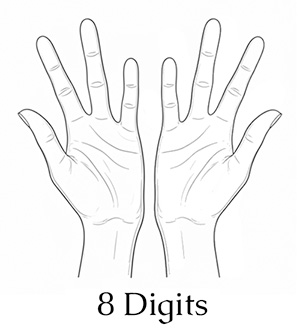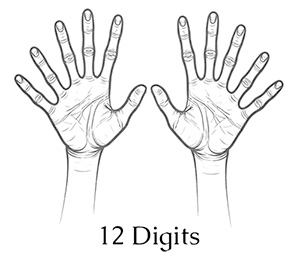Beyond Counting to 10
Introduction
We use ten digits—'0' through '9'—mostly because we have ten fingers/digits. If we had eight or twelve fingers, we’d count using only eight or twelve digits. When we base our counting on ten digits, that’s called base 10. It’s so natural to us that we hardly ever question it, but it’s not the only way to count.
What if our number system was shaped differently? Imagine a world of eight-fingered shopkeepers, pricing their wares and calculating their profits in base 8.


Alternative number bases unlock patterns and relationships hidden in the familiar. Base 2 powers modern technology, while base 12 once guided ancient commerce and design. (And base 12 still guides our clocks.) By stepping beyond our ten-fingered norm, we can uncover fresh ways of thinking, creating, and understanding.
In the Scriptorium, we’ll explore these alternate number systems — not to master mathematics, but to marvel at how they can shape art, music, and the very way we think. Each system is a new horizon, and each number holds secrets waiting to be discovered.
Counting
Note: for number bases greater than 10, we'll run out of digits. So after '9' we start using the upper-case letters of the alphabet:
0, 1, 2, 3, 4, 5, 6, 7, 8, 9, A, B, C, D, E, F, ...
Occasionally computers use base 64 (!!). To have enough 'digits' we add the lower case alphabet (a-z) and two symbols:
ABCDEFGHIJKLMNOPQRSTUVWXYZabcdefghijklmnopqrstuvwxyz0123456789+/
| Decimal | Base 2 | Base 3 | Base 4 | Base 5 | Base 6 | Base 7 | Base 8 | Base 9 | Base 10 | Base 11 | Base 12 | Base 13 | Base 14 | Base 15 | Base 16 |
|---|---|---|---|---|---|---|---|---|---|---|---|---|---|---|---|
| 1 | 1 | 1 | 1 | 1 | 1 | 1 | 1 | 1 | 1 | 1 | 1 | 1 | 1 | 1 | 1 |
| 2 | 10 | 2 | 2 | 2 | 2 | 2 | 2 | 2 | 2 | 2 | 2 | 2 | 2 | 2 | 2 |
| 3 | 11 | 10 | 3 | 3 | 3 | 3 | 3 | 3 | 3 | 3 | 3 | 3 | 3 | 3 | 3 |
| 4 | 100 | 11 | 10 | 4 | 4 | 4 | 4 | 4 | 4 | 4 | 4 | 4 | 4 | 4 | 4 |
| 5 | 101 | 12 | 11 | 10 | 5 | 5 | 5 | 5 | 5 | 5 | 5 | 5 | 5 | 5 | 5 |
| 6 | 110 | 20 | 12 | 11 | 10 | 6 | 6 | 6 | 6 | 6 | 6 | 6 | 6 | 6 | 6 |
| 7 | 111 | 21 | 13 | 12 | 11 | 10 | 7 | 7 | 7 | 7 | 7 | 7 | 7 | 7 | 7 |
| 8 | 1000 | 22 | 20 | 13 | 12 | 11 | 10 | 8 | 8 | 8 | 8 | 8 | 8 | 8 | 8 |
| 9 | 1001 | 100 | 21 | 14 | 13 | 12 | 11 | 10 | 9 | 9 | 9 | 9 | 9 | 9 | 9 |
| 10 | 1010 | 101 | 22 | 20 | 14 | 13 | 12 | 11 | 10 | A | A | A | A | A | A |
| 11 | 1011 | 102 | 23 | 21 | 15 | 14 | 13 | 12 | 11 | 10 | B | B | B | B | B |
| 12 | 1100 | 110 | 30 | 22 | 20 | 15 | 14 | 13 | 12 | 11 | 10 | C | C | C | C |
| 13 | 1101 | 111 | 31 | 23 | 21 | 16 | 15 | 14 | 13 | 12 | 11 | 10 | D | D | D |
| 14 | 1110 | 112 | 32 | 24 | 22 | 20 | 16 | 15 | 14 | 13 | 12 | 11 | 10 | E | E |
| 15 | 1111 | 120 | 33 | 30 | 23 | 21 | 17 | 16 | 15 | 14 | 13 | 12 | 11 | 10 | F |
| 16 | 10000 | 121 | 100 | 31 | 24 | 22 | 20 | 17 | 16 | 15 | 14 | 13 | 12 | 11 | 10 |
| 17 | 10001 | 122 | 101 | 32 | 25 | 23 | 21 | 18 | 17 | 16 | 15 | 14 | 13 | 12 | 11 |
| 18 | 10010 | 200 | 102 | 33 | 30 | 24 | 22 | 20 | 18 | 17 | 16 | 15 | 14 | 13 | 12 |
| 19 | 10011 | 201 | 103 | 34 | 31 | 25 | 23 | 21 | 19 | 18 | 17 | 16 | 15 | 14 | 13 |
| 20 | 10100 | 202 | 110 | 40 | 32 | 26 | 24 | 22 | 20 | 19 | 18 | 17 | 16 | 15 | 14 |
| 21 | 10101 | 210 | 111 | 41 | 33 | 30 | 25 | 23 | 21 | 1A | 19 | 18 | 17 | 16 | 15 |
| 22 | 10110 | 211 | 112 | 42 | 34 | 31 | 26 | 24 | 22 | 20 | 1A | 19 | 18 | 17 | 16 |
| 23 | 10111 | 212 | 113 | 43 | 35 | 32 | 27 | 25 | 23 | 21 | 1B | 1A | 19 | 18 | 17 |
| 24 | 11000 | 220 | 120 | 44 | 40 | 33 | 30 | 26 | 24 | 22 | 20 | 1B | 1A | 19 | 18 |
| 25 | 11001 | 221 | 121 | 100 | 41 | 34 | 31 | 27 | 25 | 23 | 21 | 1C | 1B | 1A | 19 |
Convert
Note: This base conversion tool handles fractions. For example:
12.34 base 10 ≈ 15.22 base 7.
Famous Numbers
Transcendental Numbers
In mathematics, a 'transcendental number' is one for which no finite combination of integers, addition, subtraction, multiplication, division, and exponents can equal its value exactly. Transcendental numbers are infinite, non-repeating decimals. They transcend our ability to calculate them exactly.
One of the most famous equations in math — "Euler's Identity" — uses two of these transcendental constants: π and e:
See Euler's Identity

The Constant Pi (π)
Pi (π) to 200 places in bases 2 through 16. Pi (π) represents the ratio of a circle's circumference to its diameter, and appears all over mathematics and science — sometimes in rather surprising places... More...
The Constant e
e to 200 places in bases 2 through 16. The mathematical constant e, approximately 2.718, is the base of the natural logarithm and is widely used to model real-world phenomena involving growth and change. More...
The Constant Phi (φ)
φ to 200 places in bases 2 through 16. Without getting into the math of it, φ — the golden ratio (approximately 1.681) — is a special proportion which shows up in nature, art, and design, making things feel balanced and beautiful. It’s found in the way flowers arrange their petals, the spiral of a seashell, and in great works of art and architecture like the Mona Lisa and the Parthenon. More...